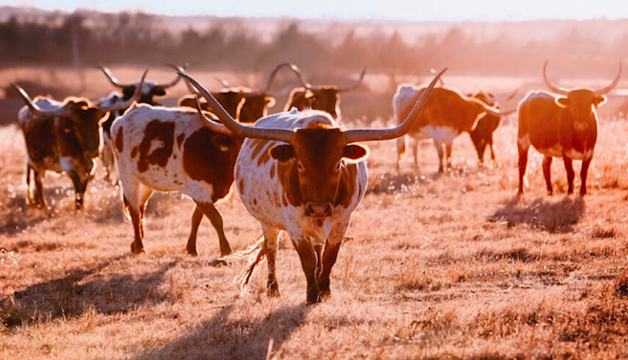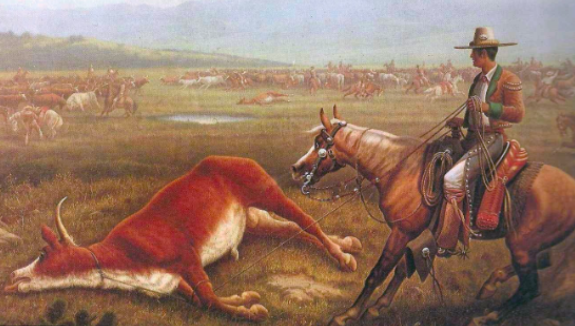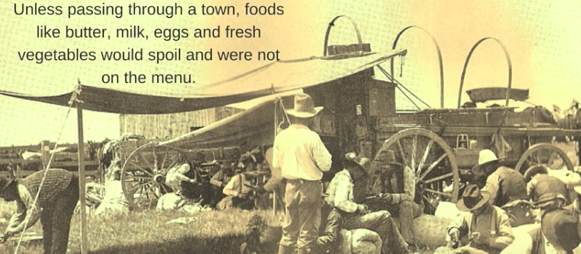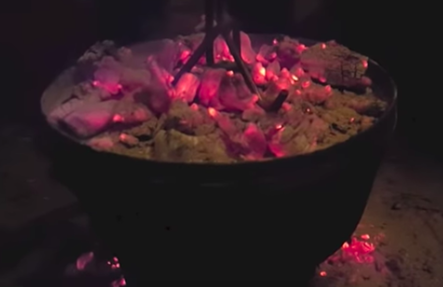 Texas Longhorn cattle.
Texas Longhorn cattle. Sue McCoy
We should remember that today there are enormous cattle ranches in the southwest, and that daily life on a ranch today is not too different from life for the nineteenth-century ranchers. There are still chuck wagons to feed cowboys out in the field, and the clothing and gear are much the same. Here are some details about the cowboys’ traditional clothing and gear, which was derived from the vaquero in Mexico and other parts of Latin America. The Spanish word for cowboy is vaquero, based on the word vaca or cow.
BOOTS
Western cowboy boots in the nineteenth century were adapted from the Mexican vaqueros, whose clothing was based in turn upon Spanish ranchers' clothing and boots. Following the Spanish conquistadors in Mexico were Spanish cattle ranchers working in northern Mexico and regions of the present American southwest: Texas, New Mexico, Arizona, and later in California.
Leather boots were worn in many ancient cultures in Europe and Asia because riding horseback was the transportation for both peace and wartime. Over time the style of leather boots, saddles, and leather clothing was adapted to local needs. The vaqueros and the cowboys were usually working in deserts with cactus, snakes, dirt, and mud, making a high-top leather boot more useful.
By the nineteenth century in the southwest, stirrups were common on saddles. The cowboy boot has tapered, rounded, or squared-off toes that make sliding the boot into a stirrup easier, and it has a higher heel so the boot “hooks” onto the stirrup securely. Cowboys were not rich, so they required a sturdy leather boot that was as cheap as possible. The fancy tooled boots of today developed later as cowboy boots moved into more fashionable, less utilitarian modes.
A cowboy was proud of his spurs, and often made his own, with leather straps to attach to his boots. Spurs were necessary as cowboys did not own their own horses, and had to ride different horses during the long cattle drives. Some horses were less docile than others, some just broken to the saddle, so using spurs occasionally was necessary to keep the horse under control. Also, cowboys in the Texas region were herding longhorn cattle, a boisterous, difficult breed to round up and contain. Skill in riding and roping was essential.
SADDLES
The exact date of the domestication of horses is in dispute, but could have possibly occurred as early as 4000 BC. The first known saddle-like equipment was used by the Assyrian cavalry around the year 700 BC. This equipment was a type of cloth padding attached around the horse with a girth or surcingle. It typically included breast straps and cruppers (a strap attached to the saddle back and looped under the horse’s tail) to aid in keeping the pad in place. These saddles were unearthed in a burial site in Siberia. They date back to 500-400 BC.
The first stirrup was a leather strap in which the rider could place only the toe. The modern day open-strap stirrup was gradually developed; it offered greater support and was essential for warfare. The stirrup was widespread across China by 477 AD and then spread into Europe.
The design of saddles slowly changed and developed over centuries of horseback riding all over Europe and Asia. Wooden saddles were brought to Europe by the Huns, a fourth-century AD nomadic fighting people, and were common through the Middle Ages. As leather working developed, and soft, durable hides were created, the saddle ‘tree’ (the wooden frame) was first covered in leather, and by the nineteenth century, the wooden tree was completely removed and the saddle was made entirely of leather with padding. A saddle blanket is placed under the saddle.
The Spanish introduced horses to the North American Indians of the southwest. Today’s western saddle is an adapted version of the Spanish conquistadors' saddle to the vaquero’s working saddle. Saddle design was changed to suit the needs of ranchers, vaqueros, and cowboys. The primary addition was the saddle horn, developed to hold the cowboy’s lariat (from Spanish riata, or lariat), and the higher cantle (back of saddle seat) for strapping gear behind the saddle.
Cowboys owned their saddles and they were valuable because a cowboy owning a saddle could more easily find work. The saddle served the cowboy as a pillow at night under the stars. They carefully kept the leather soft and supple by waxing it regularly.
CHAPS
The concept of chaps was introduced by the Spanish to protect their legs from cactus, brush, and thorns. They called them “chaparreras,” which meant leather breeches or "leg of iron". The first chaps were just large pieces of cowhide attached to the saddle; later they were detached to wrap entirely around the legs, called “shotgun” chaps because they looked like a double-barreled shotgun. After the cattle industry reached California, vaqueros often used goat, sheep, wolf, bear, or mountain lion pelts with the fur left intact. Chaps covered the thighs, providing warmth in cold and wet weather.
Chaps today are often made from hides with showy skins, fringes, or silver ornaments, and are laced on. There are different shapes of chaps as well, some are straight and some curved with a flared side, called “batwings.”
GLOVES AND SCARVES
Buckskins, waterproof gloves with high pieces covering the wrists and lower arms, were often called “gauntlets.” They protected hands from rope burns and the rein straps, as well as other hard-usage, and for cowboys, protected shirt cuffs from fraying so readily. Gauntlets were in common use in Europe for centuries. Cowboys had kerchief squares tied around their necks to pull over mouth and nose in dusty conditions. These were always in bright colors. The famous red cotton “bandanna” was the neck scarf used by cowboys, and is still popular today. (The word “bandanna” is from the 18th century, probably from Portuguese.
HATS
The wide-brimmed cowboy hat (later popularized by the Stetson company) was patterned after the vaquero’s hat. The misleading term “ten-gallon hat” does not mean that it held ten gallons of liquid. The term “tan galán” in Spanish translates in English to "so handsome." It's worth noting that the Spanish word “galón” translates as “braid” in English. One staple of many cowboy hats is a narrow leather hatband wrapped around the base crown, and was thus called the “braided hat." It's possible that cowboys may have overheard Spanish speakers referring to western-style hats as handsome or braided and misheard their words as "ten-gallon.”
The wide-brimmed and water-proofed wool or leather hats were good protection from sun and rain. The curved brim allowed rain water to run off down the back.
RAIN GEAR
Long water-proofed or oiled cloth coats, split up the back for wearing in the saddle, gave some protection from rain. Inner straps held the two lower pieces around the legs for riding.
Heavy canvas tarps carried rolled behind the saddle could serve as makeshift tents over sleeping bags or blankets. Either rolled around blankets, or partly under the blanket and propped over the head and shoulders, canvas gave a little protection for saddle and cowboy at night.
CHUCK WAGONS AND COOKING
On ranches today and on the nineteenth-century cattle drives, the chuck wagon carried a portable kitchen, supplies for two months, equipment, and was the cook’s bed. The eighteenth-century word “chuck” meant food. These were horse-drawn covered wagons, with curved staves stretched over the wagon bed and covered with a canvas. When camped, the canvas was removed from the wagon staves and stretched out like a tent behind the wagon, covering the kitchen cabinet on the rear of the wagon and making a covered cooking and serving area.
The kitchen portion was a cabinet with storage areas for food supplies and small tools, with cast-iron pots and skillets hanging on the sides. There was an iron grill on legs, several feet wide, to be placed over a fire pit to hang pots or place skillets.
Basic supplies were: flour, sourdough starter, salt pork, dried beans, lard, bacon, potatoes, coffee beans, molasses, sometimes dried fruit for pies. Meals were usually coffee, beans cooked with salt pork, bacon, beef stew with potatoes, and sourdough biscuits. Breakfast was coffee, bacon, biscuits, maybe beans. Cowboy coffee was ground coffee beans boiled in a huge coffee pot of water until the right color…and strength. Plates and mugs were made of tin, knives, forks, and spoons were the “eatin’ irons.”
Richard Nowlin, a cowboy and rancher in central Texas for 45 years, said this about the cook’s life: “…Then, of course, in a cow camp, … you just eat when you get to it. There’s always somethin’ there to eat —he always keeps somethin’ there to eat when you get in. But he had a pretty rough time of it!”
The cook rode ahead, setting up the wagon, and cooking the beans or stew that required hours of cooking. Making a long pit in the ground, a fire was built and allowed to burn down into hot coals, adding fuel as needed. The long metal grill was set over this fire pit. The ‘dutch oven‘ used for most cooking was a a large cast-iron pot with short legs, a bail handle, and a rimmed lid. This could either hang over the fire by a hook from the grill, or be sunken into a small fire pit by itself with coals on the lid, thus creating a small oven in the ground. Biscuits were cut and placed into this dutch oven to bake over the fire, sometimes fruit pie with a crust was baked in the pot. It took some skill to prevent food from burning over a hot open fire! Skillets were used on top of the grill to cook bacon, and sometimes biscuits.
RODEOS
With the fencing of the open range in the late 1880s, the cattle industry changed to a more confining job for the range cowboy. When communities sprang up, social occasions like the Fourth of July celebrations gave cowboys a chance to challenge the bronc riding and roping skills of cowboys from other ranches. Riding, roping, and branding, and even the word rodeo ("roundup") originated with the vaqueros as they worked in areas where there were stray cattle and horses. Soon local contests became annual events.
Since the cowboy's work was often seasonal, some cowboys also signed up to exhibit their skills with wild-west shows such as the first one William F. Cody (Buffalo Bill) staged in his home town of North Platte, Nebraska, on the Fourth of July, 1882. Wild-west shows led exhibitions of rodeo skills in the East and eventually in Europe. By the 1890s rodeo had become a spectator event in the West. Rodeo became an annual event in many places. Two of the earliest rodeos on record were held in Pecos, Texas, in 1883, the first to give prizes, and in Prescott, Arizona, in 1888, the first to charge admission. The first indoor rodeo took place at Fort Worth in 1917. By the late 1920s rodeo had become an annual event in some places in the East. In New York City, the Madison Square Garden Rodeo often lasted for thirty days. It was followed by a two-week rodeo in Boston. This gave rodeo national publicity. Rodeo became viewed as entertainment by the public and in 1929 the Rodeo Association of America was organized by several rodeo committees (the people who put the rodeos on, not the cowboys) to standardize rules, establish a point system to determine world champions, monitor judges, and establish a fair practice in advertising and awarding prize money. Although the RAA helped correct some of the problems in rodeo, the idea of the cowboys' having their own organization surfaced at different times, but no permanent organization occurred until October 30, 1936, when sixty-one cowboys voted to strike in protest of the prize money offered at Boston. As a result, the cowboys were given their "fair share of the prize money."
Women were included in less dangerous skills, such as barrel-racing. Rodeo clowns were important to rush in and distract violent animals when cowboys fell. Barrels were always on the field for the clowns to jump into when threatened by raging bulls. Recently the question of whether animals suffer from their treatment in rodeos has resulted in less attention to the rodeos themselves.
THE ROMANCE OF THE COWBOY
Hollywood in the 1920s and 30s did much to romanticize the cowboy culture. None of the movie cowboys would have made the grade in 1860 Texas. Gene Autry and Roy Rogers created the famous “singing cowboy” image, with songs written about the west and ranching, such as “Don’t Fence Me In” and “Home on the Range.” Later films and TV shows built on cowboy lives and ranchers’ issues, “Bonanza” was one such show.
In the 1980s Cowboy Poetry was brought to the attention of the country through annual festivals held in Elko,Nevada where real cowboys read their poetry. One definition of cowboy poetry is:
"It [is] a jazz of Irish storytelling, Scottish seafaring and cattle tending, Moorish and Spanish horsemanship, European cavalry traditions, African improvisation, and Native American experience, if also oppression. . . . the songs and poems of the American cowboy are part of that old tradition of balladry." —Western Folklife Center Archive
As cowboys spend hours alone on the range, they naturally turn to making up stories or poems about their lives. The particulars derive from the American West: horses, cattle, fire, prairie storms, mythic figures of cowboys and ranchers, and the sublime wilderness. The use of forms such as ballads and odes and of poetic devices such as mnemonics and repetition sets cowboy poetry apart from the majority of contemporary poetry and relates it more to the Homeric tradition of oral poetry.
Elements of cowboy dress and life entered into Country and Western Music, the Grand ‘Ole Opry in Nashville, Tennessee broadcast on radio in the 1940s to audiences in the southeast and southwest, bringing a different aspect of cowboy romance. Square-dancing and line-dancing promote cowboy and western clothing styles, although the dances themselves originated in the English Border countries and Ireland, and were brought to America in the eighteenth century by the emigrants to Appalachia.
Sources:
Cochise Leather Company. History of Western Leather, Spurs, Chaps and Saddles. retrieved from cochiseleather.com/leather-history.aspx
Academy of American Poets. Retrieved from poets.org
Additional websites: grizzlyrose.com; quarterhorsenews.com; lonehand.com; www.horse.com; www.thc.texas.gov (Texas State Historical Assoc.)



 RSS Feed
RSS Feed
